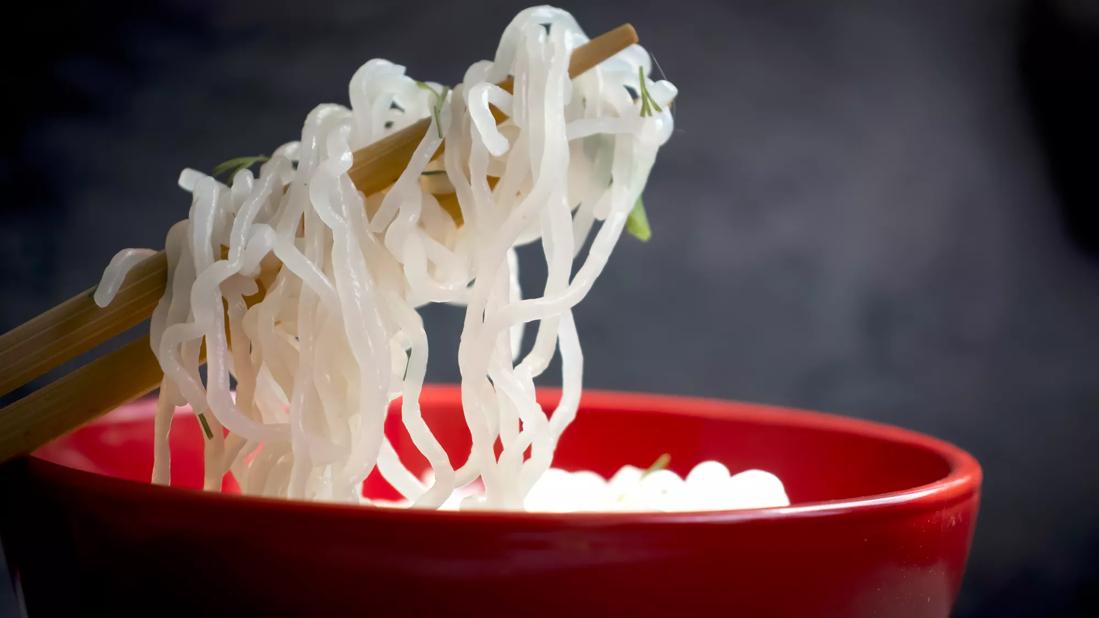Fiber-rich shirataki noodles may improve blood sugar, aid in digestion and help with weight loss

Can a food work miracles?
Advertisement
Cleveland Clinic is a non-profit academic medical center. Advertising on our site helps support our mission. We do not endorse non-Cleveland Clinic products or services. Policy
That’s the claim some people are making about shirataki noodles. These long, clear, gelatinous noodles made from the konjac (pronounced “KAHN-jak”) plant are high in fiber but virtually calorie-free.
“People call them miracle noodles because they fill you up — like pasta — but without the carbohydrates and calories,” says registered dietitian Gillian Culbertson, RD, LD.
Culbertson explains why you may want to add shirataki noodles to your weekly meal plan.
Shirataki, which means “white waterfall” in Japanese, refers to the noodles’ see-through appearance. In addition to their “miracle noodle” nickname, shirataki noodles are called konjac noodles because they’re made from the Asian konjac plant.
“Konjac’s bulb root or corm can be ground into flour or made into a gel substance to make shirataki noodles or other foods,” says Culbertson. “Konjac is high in a type of fiber called glucomannan.”
Shirataki noodles are about 97% water and 3% konjac flour. Food manufacturers and cooks shape this boiled mixture into noodles or rice-sized pieces (shirataki rice).
“You can find dried noodles online and in the Asian food sections of your grocery store,” says Culbertson. “Wet noodles are packaged in liquid and often found alongside refrigerated tofu or other Asian food items.”
Advertisement
Sort of. Shirataki noodles don’t have antioxidants or vitamins and minerals to support body functions — and because the noodles are so low in calories and carbohydrates, you won’t get much of an energy boost from eating them. While these miracle noodles may not be a vitamin powerhouse, they do have other potential benefits, like improving digestion, lowering cholesterol and blood sugar, aiding in weight loss and enriching restricted diets.
A 1-cup serving of shirataki noodles has approximately:
Those numbers are impressive, but they don’t tell the whole story. Culbertson reviews the potential health benefits of shirataki noodles in more detail.
The glucomannan fiber in shirataki noodles is a water-soluble fiber. “Soluble fiber turns into a gel when it mixes with liquids like stomach fluids,” Culbertson explains. “This gel coats the intestines as it moves slowly through your digestive tract.”
This fiber helps:
Shirataki noodles are virtually free of carbohydrates. And their high-fiber content means the digested food moves through your intestines with minimal absorption into your bloodstream.
Compared to starchy white-flour foods, shirataki noodles:
Glucomannan-based foods like shirataki noodles have almost no calories or carbohydrates and zero fat. And the high-fiber content fills you up and staves off hunger for longer.
A systematic review found that people who have obesity or overweight and who took konjac glucomannan supplements experienced small yet significant decreases in weight. These findings suggest that adding shirataki noodles to your meals may aid weight loss.
Advertisement
Shirataki noodles don’t have wheat, milk or eggs. As a result, they can be a good option for people who have food allergies or food intolerances.
You may want to try shirataki noodles if you follow a:
You could eat shirataki noodles every day, but Culbertson doesn’t recommend it.
“Mixing up food choices and eating a variety of foods keeps you from getting bored,” she says. It’s also important to make sure you get essential vitamins and minerals.
There are other reasons you might not want to eat shirataki noodles daily:
Advertisement
Shirataki noodles are a lot like tofu. They soak up the flavors of the foods you prepare them with. But some people find that the noodles (especially those packaged in water) have a fishy odor and taste. An ammonia-like chemical called trimethylamine in konjac flour is to blame. To get rid of this aroma, Culbertson recommends rinsing the noodles in cold water for a couple of minutes before cooking.
Even though packaged wet noodles are already boiled, most people boil them again. But you don’t need to boil the noodles for long. Even dry-packaged noodles are ready to eat after three minutes in boiling water. Don’t worry if you lose track of time. The high water content in konjac noodles means they’re impossible to overcook.
“After straining, some people prefer to sauté the noodles in a dry (no added fat) frying pan to get rid of excess water and enhance the noodles’ texture and flavor,” shares Culbertson. Next, mix the noodles with whatever sauce or seasonings you prefer — and enjoy!
Advertisement
Learn more about our editorial process.
Advertisement

Eating too much salt can put extra pressure on your blood vessels and heart

High in antioxidants and vitamin C, kohlrabi lowers disease risk, protects your heart and aids digestion

The gluten-free, fiber-rich superfood supports gut and heart health and can help with diabetes management

Wasabi root may protect against cancer, food poisoning and memory loss

Limes and lime juice are rich in vitamins, minerals, antioxidants and other nutrients

This herbal drink may ease allergies and boost prostate health

The common flavor enhancer has had a bad reputation — but here’s what the research shows

This ancient grain, packed with protein and fiber, can help with weight loss and heart health

Babies can get congested easily, but you can calm their cough by keeping them hydrated, using nasal drops and running a humidifier

Weight loss may cause loose, sagging skin and muscle loss to your rear

Several conditions, like vitiligo and fungal infection, can cause a loss of pigmentation, leading to white spots or patches on your skin